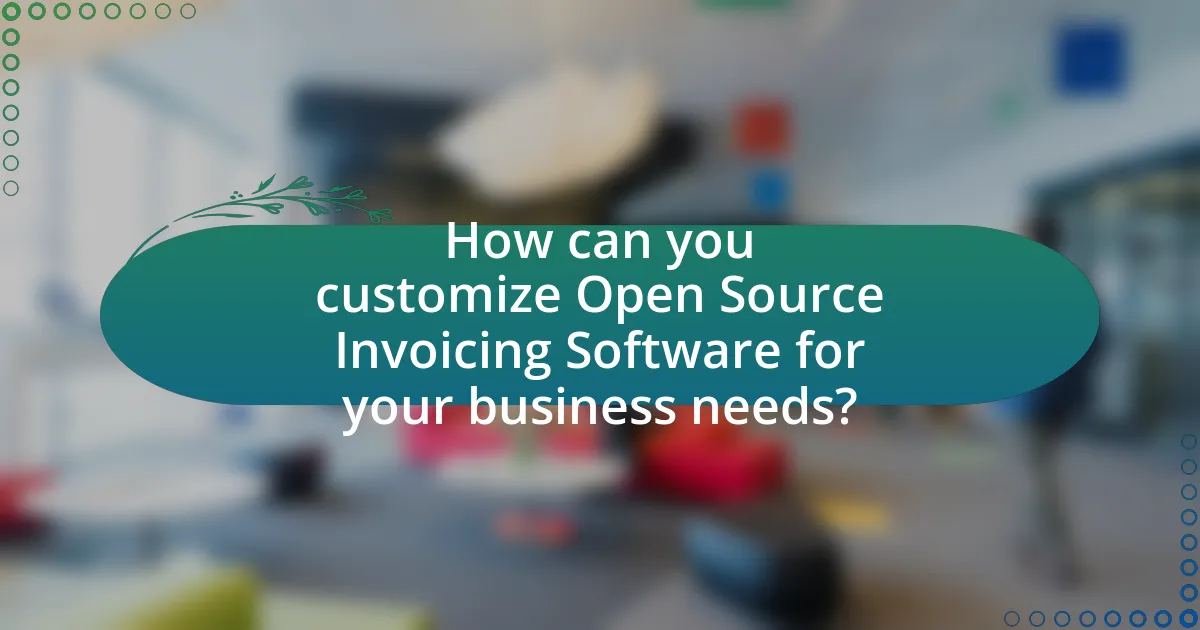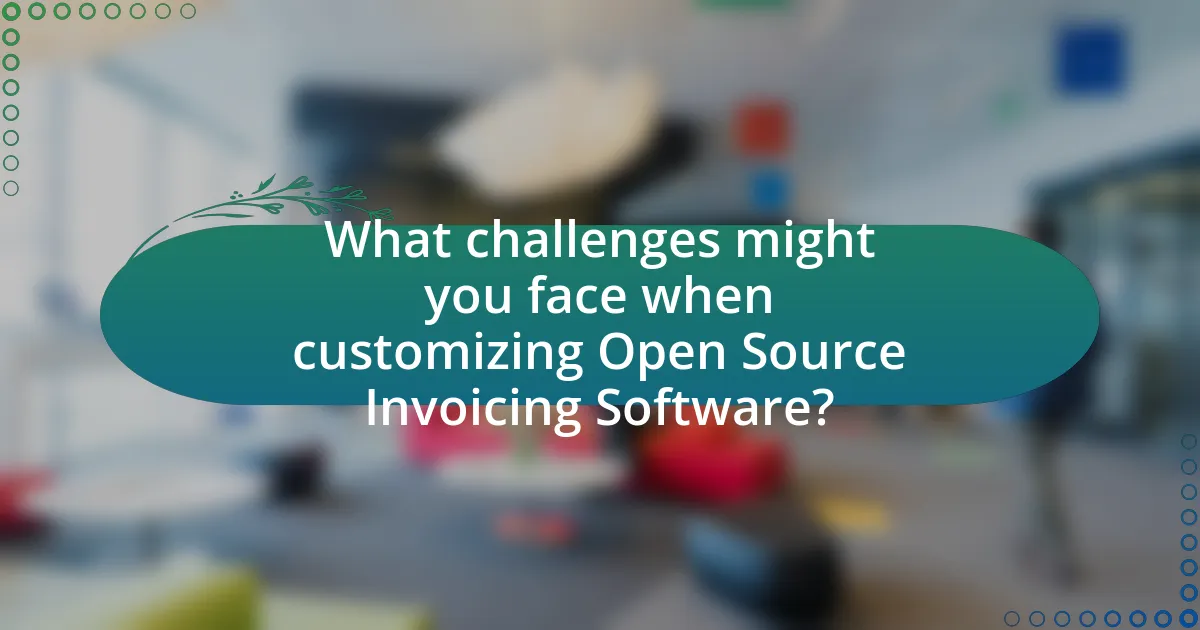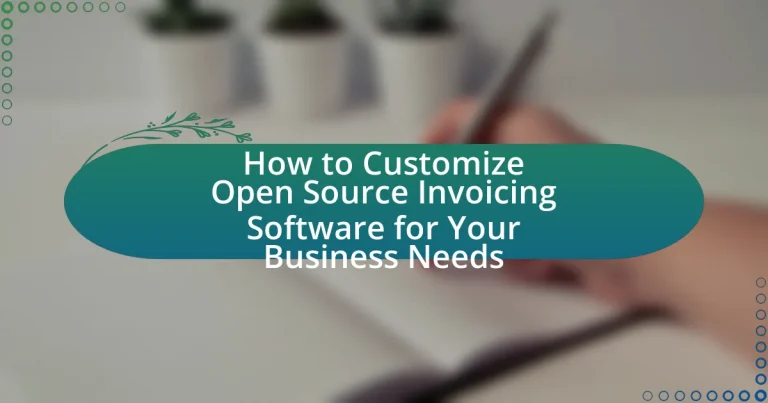Open source invoicing software is a publicly available application that allows businesses to create, manage, and send invoices with customizable features tailored to specific needs. This article explores the differences between open source and proprietary invoicing solutions, highlighting key features such as customizable templates, multi-currency support, and integration capabilities. It also discusses the benefits for small businesses, common use cases across various industries, and the steps for effective customization, including assessing business needs, implementing modifications, and ensuring ongoing maintenance. Additionally, the article addresses potential challenges and best practices for successful customization, emphasizing the importance of community support and professional services in the process.

What is Open Source Invoicing Software?
Open source invoicing software is a type of invoicing application whose source code is made publicly available for anyone to use, modify, and distribute. This software allows businesses to create, manage, and send invoices without the restrictions of proprietary software, enabling customization to meet specific business needs. According to the Open Source Initiative, open source software promotes collaboration and transparency, which can lead to enhanced functionality and security through community contributions.
How does Open Source Invoicing Software differ from proprietary solutions?
Open Source Invoicing Software differs from proprietary solutions primarily in terms of accessibility and customization. Open source software allows users to access and modify the source code, enabling tailored features and functionalities to meet specific business needs. In contrast, proprietary solutions restrict access to the source code, limiting customization options and often requiring users to adhere to the vendor’s predefined features. This fundamental difference allows businesses using open source invoicing software to adapt the system to their unique requirements, while proprietary solutions may not offer the same flexibility or control over the software’s capabilities.
What are the key features of Open Source Invoicing Software?
Open Source Invoicing Software typically includes features such as customizable invoice templates, multi-currency support, expense tracking, and integration capabilities with other software. Customizable invoice templates allow businesses to tailor invoices to their branding, while multi-currency support enables transactions in various currencies, accommodating international clients. Expense tracking helps users monitor costs associated with projects or services, and integration capabilities facilitate seamless connections with accounting software, payment gateways, and customer relationship management systems. These features enhance usability and flexibility, making open source solutions suitable for diverse business needs.
Why choose Open Source Invoicing Software for your business?
Open Source Invoicing Software is ideal for businesses due to its flexibility, cost-effectiveness, and community support. This software allows companies to customize features according to their specific needs without incurring high licensing fees, as it is typically free to use. According to a 2021 survey by the Open Source Initiative, 78% of businesses reported that open source solutions improved their operational efficiency, highlighting the practical benefits of adopting such software. Additionally, the collaborative nature of open source projects fosters continuous improvement and innovation, ensuring that the software evolves to meet changing business requirements.
What are the common use cases for Open Source Invoicing Software?
Common use cases for Open Source Invoicing Software include managing billing processes, tracking payments, generating financial reports, and customizing invoice templates. Businesses utilize this software to streamline their invoicing workflow, reduce costs associated with proprietary solutions, and enhance flexibility through customization options. For instance, according to a survey by Capterra, 60% of small businesses prefer open-source solutions for their adaptability and cost-effectiveness, demonstrating the practical benefits of using such software in various business environments.
How can small businesses benefit from Open Source Invoicing Software?
Small businesses can benefit from Open Source Invoicing Software by accessing customizable solutions that reduce costs and enhance operational efficiency. These software options allow businesses to tailor features to their specific needs without incurring licensing fees, which is particularly advantageous for startups and small enterprises with limited budgets. According to a 2021 report by the Open Source Initiative, 78% of small businesses that adopted open source software reported improved flexibility and adaptability in their operations. This adaptability enables small businesses to modify the software to align with their unique invoicing processes, ensuring better integration with existing systems and workflows.
What industries commonly utilize Open Source Invoicing Software?
Open Source Invoicing Software is commonly utilized in industries such as freelance services, small to medium-sized enterprises (SMEs), e-commerce, and non-profit organizations. Freelancers often use this software for its cost-effectiveness and flexibility, while SMEs benefit from customizable features that cater to their specific invoicing needs. E-commerce businesses leverage open source solutions to integrate invoicing with their sales platforms, and non-profits utilize it for budget management and transparency in financial reporting. These industries favor open source invoicing software due to its adaptability and the ability to modify the software to fit unique operational requirements.

How can you customize Open Source Invoicing Software for your business needs?
You can customize Open Source Invoicing Software for your business needs by modifying its source code, integrating additional features, and adjusting settings to align with your specific workflows. Open source software allows access to the underlying code, enabling businesses to tailor functionalities such as invoice templates, payment gateways, and reporting tools. For instance, companies can implement custom fields to capture unique data relevant to their operations, ensuring that the invoicing process meets their specific requirements. Additionally, many open source invoicing solutions offer plugins or modules that can be added to enhance capabilities, such as integrating with accounting software or CRM systems, which further supports customization.
What customization options are available for Open Source Invoicing Software?
Open source invoicing software offers various customization options, including template modifications, feature extensions, and integration capabilities. Users can alter invoice templates to reflect their branding by changing logos, colors, and layouts. Additionally, developers can extend functionalities through plugins or modules, allowing for tailored features such as payment gateways or reporting tools. Integration with other software, such as accounting systems or CRM platforms, is also possible, enabling seamless data flow and enhanced operational efficiency. These customization options empower businesses to adapt the software to their specific needs, ensuring it aligns with their operational workflows.
How can you modify the user interface to suit your brand?
To modify the user interface to suit your brand, you can customize colors, fonts, and layouts to reflect your brand identity. For instance, using your brand’s color palette ensures visual consistency, while selecting fonts that align with your brand’s tone enhances readability and user experience. Additionally, rearranging interface elements to prioritize features that resonate with your target audience can improve usability. Research shows that consistent branding across platforms can increase brand recognition by up to 80%, reinforcing the importance of a tailored user interface.
What functionalities can be added or removed based on your requirements?
Functionalities that can be added or removed in open source invoicing software include features such as payment gateways, invoice templates, reporting tools, and user management systems. For instance, businesses can add payment gateway integrations like PayPal or Stripe to facilitate online payments, while they may choose to remove complex reporting tools if they do not require detailed analytics. The flexibility of open source software allows for these modifications to align with specific business needs, ensuring that only relevant functionalities are retained or introduced.
What are the steps to implement customizations effectively?
To implement customizations effectively, follow these steps: first, assess your business requirements to identify specific needs for the invoicing software. Next, choose the right open-source platform that allows for flexibility and scalability. After selecting the software, create a detailed customization plan outlining the desired features and functionalities. Then, develop the customizations, ensuring to follow best coding practices for maintainability. Finally, test the customizations thoroughly in a controlled environment before deploying them to production, ensuring they meet the initial requirements and do not introduce new issues. This structured approach is validated by successful case studies in software development, which emphasize the importance of planning, testing, and iterative improvements in achieving effective customizations.
How do you assess your business needs before customization?
To assess business needs before customization, conduct a thorough analysis of current workflows, identify gaps, and gather input from stakeholders. This process involves mapping existing processes to understand inefficiencies and determining specific requirements that the customization should address. For instance, a survey of team members can reveal pain points in the invoicing process, such as delays or errors, which can guide the customization efforts. Additionally, reviewing industry benchmarks can provide insights into standard practices and features that may enhance operational efficiency.
What tools and resources are necessary for customization?
To customize open source invoicing software, essential tools and resources include a code editor, version control system, and access to documentation. A code editor, such as Visual Studio Code or Sublime Text, allows developers to modify the software’s source code effectively. A version control system like Git is crucial for tracking changes and collaborating with other developers. Access to comprehensive documentation, including API references and user guides, is necessary to understand the software’s architecture and functionalities, enabling informed customization decisions. These resources collectively facilitate a streamlined customization process, ensuring that modifications align with specific business needs.

What challenges might you face when customizing Open Source Invoicing Software?
Customizing Open Source Invoicing Software can present several challenges, including compatibility issues, lack of documentation, and potential security vulnerabilities. Compatibility issues may arise when integrating the software with existing systems or third-party applications, leading to functionality problems. The lack of comprehensive documentation can hinder the customization process, making it difficult for developers to understand the software’s architecture and features. Additionally, security vulnerabilities may be introduced during customization, as modifications can create new entry points for attacks if not properly managed. These challenges highlight the importance of thorough testing and careful planning when customizing open source solutions.
How can you overcome technical challenges during customization?
To overcome technical challenges during customization of open source invoicing software, implement a structured approach that includes thorough documentation, community support, and iterative testing. Thorough documentation provides clear guidelines and reference points, which help in understanding the software’s architecture and functionalities. Engaging with community support, such as forums and user groups, allows for sharing experiences and solutions to common issues, enhancing problem-solving capabilities. Iterative testing ensures that each customization is validated before full deployment, reducing the risk of introducing new issues. These strategies are effective as they leverage existing resources and collective knowledge, which are critical in addressing technical challenges efficiently.
What common pitfalls should you avoid in the customization process?
Common pitfalls to avoid in the customization process include inadequate planning, which can lead to scope creep and misalignment with business goals. Failing to involve stakeholders during the customization can result in a product that does not meet user needs, as evidenced by a study from the Project Management Institute showing that 37% of projects fail due to a lack of stakeholder engagement. Additionally, neglecting to document changes can create confusion and hinder future updates, as highlighted by the Software Engineering Institute, which emphasizes the importance of documentation in maintaining software integrity. Lastly, overlooking testing can lead to undetected bugs, with research indicating that 30% of software defects arise from insufficient testing practices.
How can you ensure compatibility with existing systems?
To ensure compatibility with existing systems, conduct a thorough analysis of the current infrastructure and identify integration points. This involves assessing the data formats, APIs, and protocols used by existing systems to facilitate seamless communication. For example, if the existing systems utilize RESTful APIs, the new software should also support RESTful communication to ensure interoperability. Additionally, utilizing middleware solutions can bridge gaps between different systems, allowing for data synchronization and process automation. Compatibility testing should be performed to validate that the new software interacts correctly with existing systems, minimizing disruptions and ensuring a smooth transition.
What support options are available for customizing Open Source Invoicing Software?
Support options for customizing Open Source Invoicing Software include community forums, documentation, and professional services. Community forums provide a platform for users to share experiences and solutions, while comprehensive documentation offers guidelines and tutorials for customization. Additionally, professional services from developers or companies specializing in open-source software can provide tailored support and advanced customization options, ensuring that businesses can effectively adapt the software to their specific needs.
How can community forums assist in the customization process?
Community forums assist in the customization process by providing a platform for users to share experiences, solutions, and modifications related to open source invoicing software. These forums enable users to ask specific questions and receive tailored advice from experienced community members, which can lead to effective customization strategies. For example, users can find code snippets, plugins, or configuration tips that have been successfully implemented by others, thereby accelerating their own customization efforts. Additionally, community forums often host discussions on best practices and common pitfalls, which can help users avoid mistakes and enhance the functionality of their invoicing software.
What role do professional services play in customization?
Professional services play a crucial role in customization by providing expertise and tailored solutions that align software functionalities with specific business requirements. These services include consulting, implementation, and ongoing support, which ensure that the open-source invoicing software is effectively adapted to meet unique operational needs. For instance, professional services can analyze a company’s workflows and recommend custom features or integrations that enhance efficiency and user experience, thereby maximizing the software’s value.
What best practices should you follow for successful customization?
Successful customization of open source invoicing software requires a clear understanding of business needs and user requirements. First, conduct a thorough analysis of your specific invoicing processes to identify areas that need customization. This ensures that the modifications align with your operational goals. Next, prioritize user experience by involving end-users in the customization process, as their feedback can guide effective design and functionality improvements.
Additionally, maintain documentation throughout the customization process to track changes and facilitate future updates or troubleshooting. Implementing version control is also crucial, as it allows you to manage changes systematically and revert to previous versions if necessary. Lastly, ensure that the software remains compliant with relevant regulations and standards, which can prevent legal issues and enhance reliability. Following these best practices can lead to a more effective and tailored invoicing solution that meets your business needs.
How can you ensure ongoing maintenance and updates after customization?
To ensure ongoing maintenance and updates after customization, establish a dedicated support team responsible for monitoring and implementing updates. This team should regularly review the software for new releases, security patches, and compatibility issues with other systems. Additionally, implementing a version control system allows for tracking changes and facilitates easier updates. According to a study by the Software Engineering Institute, organizations that maintain a structured update process experience 30% fewer security vulnerabilities. Regular training for the support team on the latest software developments further enhances the effectiveness of maintenance efforts.
What strategies can help you gather user feedback on customizations?
To gather user feedback on customizations effectively, implement strategies such as surveys, user interviews, and usability testing. Surveys can be distributed via email or integrated within the software, allowing users to provide structured feedback on specific features. User interviews facilitate in-depth discussions, revealing insights into user experiences and preferences regarding customizations. Usability testing involves observing users as they interact with the software, identifying pain points and areas for improvement. Research indicates that companies utilizing these methods can enhance user satisfaction and drive product improvements, as evidenced by a study from the Nielsen Norman Group, which found that usability testing can uncover issues that surveys alone may miss.




